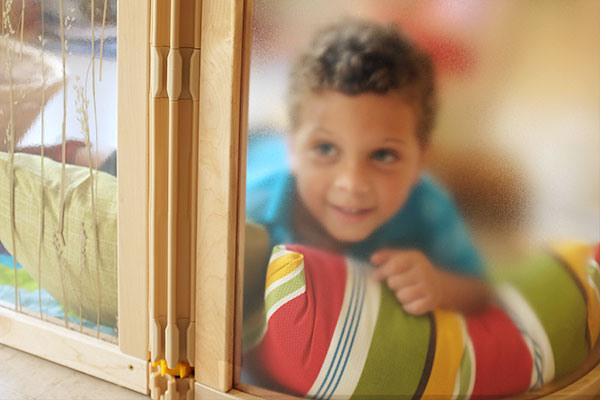Sensory play for children with special educational needs
| June 2019

Positive action
Regardless of SEN, many children find paying attention a key challenge. A number of proactive strategies can help, such as allowing the use of sensory-rich resources to provide feedback; providing quiet spaces to sit in calmly and take time out; minimising other distractions; and using attractive resources to encourage less-preferred activities (Christine Mcintyre, 2005). As with all children, it is a case of understanding each individual to discover the types of resources or activities that will best captivate them. Appropriate sensory stimulation increases children’s concentration and focus, helping them to self-occupy. It can also develop muscle tone and is inclusive because there are no right or wrong ways of playing, appealing to children with different learning styles and abilities. For a child who needs proprioceptive feedback – from touching ribbons or other tactile resources – in order to sit still, this needs to be understood in the same way that a pair of spectacles or a wheelchair would be. Many children develop stims (self-stimulations) like flapping their arms or rocking. These individual coping mechanisms help them deal with the problem, giving respite from a world of bombardment. If inappropriate, children can be helped to develop more socially acceptable coping mechanisms with professional support, and should not be denied this opportunity for self- expression.
Many children with autism benefit from being in a “just right” state, where they are neither over nor under-stimulated. Accessing a “diet” of appropriate sensory-rich play and learning opportunities throughout the day can help children achieve this (Patricia Wilbarger and Julia Wilbarger, 1991). A sensory room, low-cost “sensory den,” ball pool, gym or aqua pool are great for providing a real sensory workout or “main meal”. But sensory stimulation also needs to take place in between these times, in non-specialised environments, involving little or no specialist planning or provision. “Sensory snacks” are opportunities for children to play with sensory-rich resources in situ, making them perfect for use in early years settings, mainstream schools and in the home. So what might a sensory-rich learning environment look like in practice?
The sensory room – a sensory “main meal”
The sensory room (or a lower-cost smaller/portable version) is an all-singing, all-dancing sensory environment with much to offer children with SEN. The coloured lights, dark and calm environment, sounds and sights of bubbles and water all have a key role to play and can be controlled to make a real difference to children’s lives, providing a respite form constant sensory overload. Like aqua pools and gyms, this all-encompassing provision can offer large-scale sensory experiences, albeit at a price and on a scale that may limit provision to specialist schools.
Although multi-sensory by name, the resources in a typical sensory room can be predominantly plastic or fabric, offering little in the way of sensory stimulation to the tactile sense, so this may be something to consider if the children who will be accessing the room benefit from tactile stimulation.
Treasure baskets – a “sensory snack”
A treasure basket is an example of a sensory-rich and highly portable resource, making it a perfect “sensory snack”. Within an enabling environment children can investigate objects, experiment, or be guided with activities. The sensory stimulation and hands-on approach is great for brain and memory development, gross and fine motor skills and strength. With no right or wrong ways of playing, they can appeal to children with different learning styles and abilities.
To avoid sensory overload some children may need to be offered the “treasures” individually or just a few at a time. Other children may need heavy items to be removed (to avoid potential danger from throwing) or more robust alternatives to be provided instead. Still others may need to be supported in moving play on to avoid overly repetitious play.
The outdoor environment – a “main meal” or “sensory snack”
With an emphasis upon access to play opportunities outdoors, making a distinction between formal learning indoors and “running around” outdoors would be to seriously limit the real play and learning potential of the outdoor environment, marginalising it as simply a place to “let off steam”. With flexibility, the outdoor environment can come to offer both a “sensory snack” and “main meal”, avoiding much of the sensory overload likely to be so difficult for children with sensory processing problems.
A study of the effects of green space upon mood and self-esteem revealed that even five minutes exposure generated positive effects, with the presence of water increasing this still further. Research also suggests that “exposure to greenery” benefits children’s ability to pay attention, with children with ADHD (Attention Deficit Hyperactivity Disorder) significantly reducing their symptoms. Interestingly, the greener the environment, the greater the change was evident (American Journal of Public Health, September 2004; Barton, J. & Pretty, J. 2010). Follow-up studies of children with ADHD taken on a 20-minute walk in the park revealed similar elevated attention levels to a dose of Ritalin. Furthermore, simply providing views of green areas increased attention and reduced impulsiveness among those without ADHD, particularly girls – proof of the positive benefits of access to a sensory-rich environment (Montessori International, April–June 2011).
In a research project carried out by Redcliffe Children’s Centre in Bristol six children aged three to four years with wide ranging additional needs were taken on weekly visits to a wild space in a local wood. Over a period of nine months the challenge, calm, space, freedom from loud noises and other sensory irritants, as well as the changing environment increased children’s confidence, communication, cognitive development and attitude to risk.
“The forest environment seemed a wonderful place to stimulate all of the senses in a natural and balanced way. Sensory integration appeared to work very effectively and all children showed that they were able to process whether a sensation was from their own body or from the environment.”
Implications for adults
Staff too, at Redcliffe experienced a learning journey, gaining a better understanding of children’s capabilities and pushing the boundaries of what they felt was acceptable in terms of risk and challenge. While watching a child struggle to scale a hill, practitioners questioned the process, but once achieved, the pride, satisfaction and pure joy of the child convinced them of the value of children experiencing challenge and risk. An observation of teenagers playing with a treasure basket in a special school revealed similarly surprising results. The children freely engaged with the objects and to the surprise of practitioners, examples of sensory regulation (using objects to achieve a “just right” state) and imaginative play emerged. One boy discovered a tin designed to look like a mini-postbox and proceeded to put objects in it saying he was posting them. He then got into the role of a postman, making deliveries to people around the room. Imaginary play and using an object to represent something else are not typically associated with children on the autistic spectrum and so was particularly noteworthy for the practitioners observing this session.
Examples like these emphasise the importance of the senses and the fact that some children’s responses to sensory stimulation can impact upon their ability to participate in play and learning. Equipped with this knowledge we can better understand and effectively plan for children’s needs, raising our expectations of what children with SEN can achieve within an enabling environment. Sensory resources like a treasure basket can also be a valuable aid in identifying potential problems. Take this example of four babies under eight months sat around a treasure basket. Three of the four were eager, excited and exploring the objects, while the fourth, a very passive baby, did not take part. She was later diagnosed with severe developmental delay (Katrin Stroh et al., 2008).
Since all learning starts with our senses, sensory-rich play opportunities should be a natural ingredient in any enabling environment. As we discovered in chapter three, for typically developed children, multi-sensory play is great. However, for children with SEN we need to be aware of the very different impacts of sensory stimulation to ensure that with careful support we can help give children “the best start in life” as well as lots of fun!
Excerpted from Sensory Play (pp. 48–51), by Sue Gascoyne. Published by Practical Pre-School Books; used with permission of the publisher.








